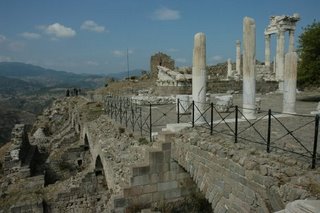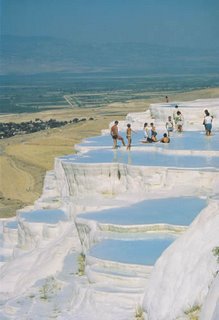Thursday, October 12, 2006
This morning we departed our hotel at 5:00 am, and took an early flight to the Western Coast of Turkey. Our new guide, Ahu, met us at the airport. We quickly boarded a small bus and headed off to the city of Izmir, which was the closest large city to Pergamum. The modern day name of Pergamum is Bergama. The city was founded by the Greeks in the 8th century BC.
Pergamum sits high on a hill overlooking the valleys beneath. The ruins of the city sprawl across the top of the hill and the temple of Hadrian stands out with it's marble columns. Here is a shot of Marla running around beneath the Temple of Hadrian.
 None are perfectly intact today due to centuries of earthquake damage and many of it's treasures and statues are missing due to German archeologists taking many of the great artifacts from this area and placing them in German museums in the early 20th century. Turkey is still attempting to negotiate with Germany for the return of ancient artifacts taken.
None are perfectly intact today due to centuries of earthquake damage and many of it's treasures and statues are missing due to German archeologists taking many of the great artifacts from this area and placing them in German museums in the early 20th century. Turkey is still attempting to negotiate with Germany for the return of ancient artifacts taken. This is the Temple of Hadrian, which dates back to 117-118 AD.

The city of Pergamum was home to one of the 7 churches written to in the book of Revelation. The angel warned the church to repent, to give up the worship of Balaam, and to not follow the teachings of the Nicolaitans. (The Nicolaitans were teaching that the Priests had special authority over the lay people, and had set up a self-serving hierarchy within the church.)
Nearby stand the ruins of the hospital dedicated to the Greek god Aesclepius, the god of healing. The famous doctor, Galen, worked in Asclepieion (sanatorium) of Pergamum and wrote at least 500 medical books. We walked through the sanatorium and were amazed by the techniques used to treat the mentally ill.
Patients would take a stroll through the tunnel below, which is illuminated by holes cut into the tunnel roof. Water flowed through channels on both sides of the tunnel, frescos decorated the walls, and music would be played. Physicians observed the patients as they passed through the tunnel and then directed them to a sleeping chamber where their dreams would be analyzed upon waking.

Pretty advanced stuff—sounds a good bit like some of the therapy used today.
The hospital also had a theater for the entertainment of the patients which could seat 3,500 people.

Our next stop would be Pamukkale, (Hieropolis) and Laodicea, the city of Lukewarm faith. Hierapolis was the ancient city on top of the famous hot springs, Pamukkale, in which Cleopatra is reported to have bathed. These hot springs were once rich in minerals, which often had healing properties. The city was destroyed in 17 AD by a major earthquake, and was rebuilt. In 1534 another earthquake destroyed most of the remains of the ancient city.
The pools of water were found on limestone terraces outside the city. Tourists from all over the world were wading and bathing in the pools. A few members of our group tested the water, and said that it wasn’t warm, and wondered aloud if the springs were still truly functioning.

Next stop: Laodicea
Laodicea was once an important city in Turkey, built on a natural trade route. In the Roman period it was the metropolis of Asia. It was a center of banking for the Asian trade route and was famous for it's black cloth, where the weavers used goats’ wool. The wool was a distinctive jet black, the result of the minerals in the water the sheep and goats drank. The water carried to Laodicea came from a hot spring, so that it was lukewarm by the time it reached the city. This adds to the imagery evoked when reading from Revelation in which John says that the city is lukewarm in it's faith.

The city has only just been uncovered and archeologists are presently working to excavate and restore artifacts.
 Leah has uncovered what she hopes are early building blocks.
Leah has uncovered what she hopes are early building blocks. The ride to our hotel was a long one—about three hours, in a very cramped bus. Folks took turns riding in the small ledge seat by the door, and I tried to entertain Marla with clapping games and playing I-Spy. By this day she was still traveling well, but was starting to show her fatigue— and so were we!
The ride to our hotel was a long one—about three hours, in a very cramped bus. Folks took turns riding in the small ledge seat by the door, and I tried to entertain Marla with clapping games and playing I-Spy. By this day she was still traveling well, but was starting to show her fatigue— and so were we! Here’s a shot of the hotel Altin Saray:

Reaching the hotel after dark, we managed to slip into the buffet just before closing time and grab a quick meal. Our hotel was lovely and was situated on a bay near the Aegean Sea. Unfortunately, we never had time to get near the sea—but did see it from afar. The water was the most beautiful color green. The city of Kucadaci is a popular resort town for vacationing Europeans and Asians, with many cruise ships porting there as part of Aegean cruises.
I think we were asleep before our heads hit the pillows... visions of temples, columns, marble walls, golden fields, mountaintops, and limestone pools filled our dreams.
No comments:
Post a Comment